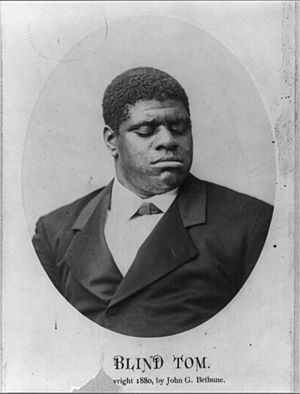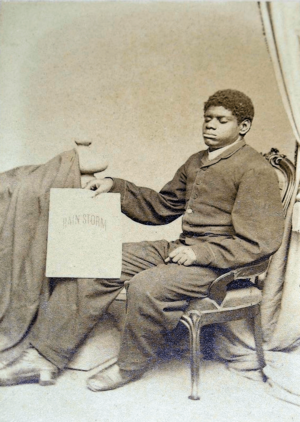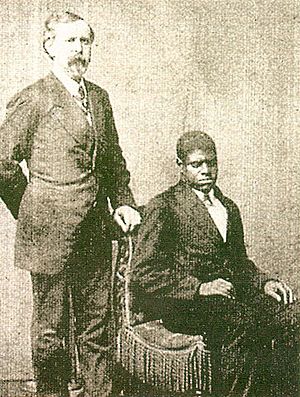Blind Tom Wiggins facts for kids
Thomas "Blind Tom" Wiggins (May 25, 1849 – June 14, 1908) was an amazing American pianist and composer. He wrote many original songs and had a long, very successful career performing all over the United States. In the 1800s, he was one of the most famous American pianists and one of the best-known African-American musicians.
Contents
Early Life and Amazing Talent
Wiggins was born Thomas Greene on a plantation in Harris County, Georgia. He was blind from birth. In 1850, he and his parents, Charity and Domingo "Mingo" Wiggins, who were also enslaved, were sold to a lawyer named General James Neil Bethune in Columbus, Georgia. Tom's name changed because he was enslaved.
Because Tom was blind, he couldn't do the usual work expected of enslaved people. Instead, he was allowed to play and explore the Bethune plantation. From a very young age, he loved the piano after hearing Bethune's daughters play. By age four, he could play some piano by ear. He even composed his first song, The Rain Storm, after hearing rain on a tin roof.
General Bethune recognized Tom's special skills. Tom was given a room near the family house with a piano. A neighbor once said that Tom seemed to live for two things: eating and music. He played the piano for about twelve hours a day!
As a child, Tom could copy sounds around him perfectly, like a rooster crowing or a bird singing. If left alone, he would make noise by banging on pots or dragging chairs. By age four, he could repeat conversations up to ten minutes long.
Tom's incredible abilities were clear when he went to a political rally in 1860. Years later, he could still repeat the speech, copying the speaker's voice and actions. He could even recreate the sounds of the crowd, like cheers and heckles, with amazing accuracy.
Becoming a Performer
When Tom was eight, General Bethune hired him out to a concert promoter named Perry Oliver. Tom toured extensively in the U.S., sometimes performing four times a day. He earned a huge amount of money for Oliver and Bethune, making him one of the highest-paid pianists of his time. The Bethune family became very wealthy from Tom's performances. Oliver advertised Tom as a unique talent, showing how he transformed from someone unable to communicate well into a brilliant artist.
Bethune hired professional musicians to play for Tom. Tom could perfectly copy their performances, often after hearing them just once. He reportedly learned 7,000 pieces of music, including hymns, popular songs, waltzes, and classical music.
There are different stories about Tom's first public performance, some saying he was as young as three. By 1857, he had been performing publicly for several years. Audiences and newspapers loved his shows. This led General Bethune to arrange concert tours for Tom, first around Georgia and then across the South. Their travels were sometimes difficult because of the growing tensions leading to the Civil War.
In 1860, Blind Tom performed at the White House for President James Buchanan. He was the first African-American to give a special performance at the White House. Famous writer Mark Twain watched many of Blind Tom's shows over the years and wrote about them.
On Stage and His Unique Style
On and off stage, Tom often referred to himself in the third person, saying things like "Tom is pleased to meet you." His piano concerts included other talents, like perfectly mimicking public figures and nature sounds. He also moved around a lot, both on and off stage.
A soldier wrote in 1862 about Tom's unusual skills: "One of his most remarkable feats was playing three pieces of music at once. He played 'Fisher's Hornpipe' with one hand and 'Yankee Doodle' with the other, and sang 'Dixie' all at the same time." He could even play with his back to the piano and his hands upside down!
Sometimes, people in the audience would challenge Tom. They would play two new songs he had never heard before, and he would play them back perfectly. This "audience challenge" became a regular part of his concerts.
During the Civil War, Tom's talents supposedly helped the Confederacy. His most famous piece, "The Battle of Manassas," told the story of a Confederate victory. Because of this, some black newspapers refused to celebrate him. They felt he reinforced negative ideas about African-Americans and only made money for slaveholders.
After Slavery and Later Career
The Emancipation Proclamation in 1862 freed enslaved people in the Confederate states. All enslaved people in the U.S. were freed when the Thirteenth Amendment passed in December 1865.
In 1866, when Tom was 16, General Bethune took him on a concert tour in Europe. They collected praise for Tom's natural talents from famous musicians like Ignaz Moscheles. These praises were printed in a booklet to boost Tom's international fame.
In 1875, General Bethune's son, John Bethune, took over managing Tom's career. John toured with Tom across the U.S. for eight years. Each summer, John brought Tom to New York. While there, Tom learned new songs from Joseph Poznanski. Poznanski also wrote down Tom's new compositions so they could be published. Tom often insisted these be published under different names.
Tom's piano playing, both practicing and performing, was very unique. Poznanski once said, "I would play for him, and he would get up, walk around, stand on one foot, pull his hair, knock his head against the wall, then sit down and play a very good imitation of what I had played with additions to it." His memory was incredible; he never forgot anything. Some critics called him a "human parrot" or a "human phonograph" because of this.
Sadly, no original recordings of Blind Tom exist today. His sheet music is available, but only a few musicians have recorded his original songs.
Later Years and Legacy
After John Bethune died in 1884, Tom was cared for by General Bethune again. Later, after a legal battle, Tom was placed in the care of Eliza Stutzbach, John Bethune's former wife. Eliza and her later husband, Albrecht Lerche, continued to manage Tom's tours for several years.
During this time, Tom often introduced himself on stage by imitating his past managers. He would talk about his own mental state, which doctors had described as non compos mentis (meaning not of sound mind). He seemed proud of this phrase. A writer named Willa Cather described how strange it was to see him walk on stage and talk about his own "idiocy" using someone else's words.
Tom continued to travel and perform until the mid-1890s, when Eliza took him off the concert circuit due to ongoing legal challenges about her care of him.
Tom spent the next ten years living with Eliza and her husband in New York City and New Jersey. In 1903, Eliza arranged for Tom to perform on the popular vaudeville circuit, starting in Brooklyn. He performed in vaudeville for almost a year.
His health began to get worse, and he likely had a stroke in December 1904. This ended his public performing career. After her husband died, Eliza moved to Hoboken, New Jersey, with Tom. They stayed out of public view, but neighbors could hear Tom playing the piano at all hours. Tom had a major stroke in April 1908 and died that June at age 59. He was buried in the Cemetery of the Evergreens in Brooklyn, New York.
Remembering Blind Tom
The people of Columbus, Georgia, placed a special headstone for him in 1976. His life has inspired plays, books, and even a song by Elton John.
- Between 1970 and 2000, Dr. Geneva Handy Southall wrote a three-volume study about Blind Tom.
- In 1981, a film called Blind Tom: The Story of Thomas Bethune was made.
- In 1999, pianist John Davis recorded an album of Tom's original compositions.
- In 2009, a full biography, The Ballad of Blind Tom, was published by Deirdre O'Connell.
- Andre T. Regan's 2013 documentary, The Last Legal Slave in America, tells Tom's story.
- The Elton John song "The Ballad of Blind Tom" (2013) is about him.
- Blind Tom Wiggins is also a character in the novel The Song of the Shank (2014) by Jeffrey Reynard Allen.
- He is featured in a series of poems in Olio (2016) by Tyehimba Jess.
- In 2019, Blind Tom was featured on a mural in New Braunfels, Texas, celebrating the city's history of arts.
|





